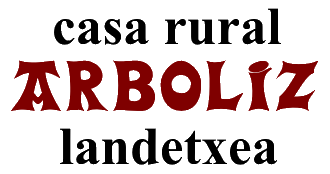History tells us that Count Tello passed a decree on April 28 1366 by which the district of Gernika was separated from the parish of Lumo and granted its own town charter. The new town stood on the crossroads where the road from Bermeo to Durango met the road from Bilbao to Lekeitio.
San Pedro de Lumo The 16th, 17th and 18th centuries were marked by continual disputes over demarcation and jurisdiction between Gernika and theneighbouring parishes of Lumo and Ajangiz.
In 1575 Lumo won a crucial lawsuit that resulted in the limits of Gernika being reduced to just 5 streets. This enabled Lumo to clauim the revenue from the fairs in the area, though they were still considered as being held in Gernika.
These confrontations finally came to an end on January 8, 1882 when the town and the parish were merged into a single municipality under the name Gernika-Lumo.
Picasso & Gernika
On April 26, 1937 Gernika suffered a terrible attack that was to mark the history of the town forever: It was bombed indiscriminately in a rehearsal by German and Italian forces for the strategy of "total warfare".
Winston Churchill described the attack as "an experimental horror" and Malaga-born artist Pablo Picasso was inspired by it to paint his internationally renowned canvas Guernica, which reflects the full barbarity of the bombing.
The bombing of Gernika took place on Monday, which was market day. The market was held at the Jardines del Ferial Park. A small, almost hidden marker now commemorates the victims of the massacre.
The Unceta y Cía. weapons factory played a major role in the Spanish Civil War, as the famous Astra handgun was manufactured there.
The Assembly House and the Tree of Gernika
For centuries Gernika has been the venue for assemblies of representatives of the towns and villages of Bizkaia.
The earliest records of their meetings beneath the now famous oak tree date from the 14th century. These assemblies sought to establish a set of laws and a system of representation of the people. The Assembly House and the Tree of Gernika are therefore must-see attractions, as they are living symbols of the history of the Basque people.
The Assembly House stands beside the great oak where in olden days the kings of Castile swore to uphold Basque laws and privileges. It is a meeting point for all the territories of the Basque Country, which share the same cultural and ethnographic traditions, extending beyond political frontiers.Nowadays it acts as the venue for such important ceremonies as the swearing in of the Premier of the Basque Government and the leader of the provincial council.
Monday in Gernika
There is a popular saying in Gernika which runs as follows: "lunes gerniqués, golperik ez". This translates roughly as "not a stroke of work gets done on Mondays". The Monday market day has for decades been considered as a holiday in the town.
People would flock to Gernika not just from the immediate vicinity but from all over the province, so that the town was packed. They came not just to buy or sell at the produce market but also to eat at the town’s renowned restaurants and afterwards perhaps to watch a pelota game at the local court.
Jai Alai
The Gernika Jai Alai court is the biggest operational court of its type in the world. It was designed by Secundino Zuazo, one of Spain’s leading architects of the 20th century, and first opened in 1963.
It is included in the Guinness Book of Records as the fastest sport in the world: the ball may travel at up to 300 km per hour.It is acknowledged by players of the game to be the finest court in the world.
Gastronomy and txakoli
From the true rustic flavour of Gernika beans to the delicate taste of the area’s green peppers, the name of Gernika rolls off the visitor’s palate as a synonym for fine cuisine.
Basque cuisine brings fine ingredients and skill together to produce masterful recipes.
Mural of "Guernica"
Although it is in the old part of town, this mural is of recent construction. A mosaic of tiles depicts in puzzle form Picasso’s great work Guernica, inspired by the bombing of the town on April 26, 1937. The original painting is currently on display at the Reina Sofía Museum in Madrid.
The Euskal Herria Museum
This museum is housed in the baroque style Alegría palazzo. Visitors can see a number of engravings and canvases illustrating the history of the Basque people, their lands, their laws and their deep-rooted traditions, such as the Tree of Gernika itself.
Convent of Santa Clara.
There has been a place of worship on this site since before records began. The convent was set up in 1422, for nuns of the Third Order of St. Francis. In 1618 the nuns asked to become a cloistered order, and requested an Abbess of the Order of St. Clare to lead them. The order was officially founded on September 16th 1619.
The building that now houses the nuns was built in 1880. This community is deeply rooted in the traditional of Gernika and of Bizkaia as a whole.
Udetxea Palace
The Udetxea Palace, built by the Allendesalazar family in 1890 as a summer residence, houses the headquarters of the Board of Trustees of the Urdaibai Biosphere Reserve.
This area possesses an outstanding natural and cultural heritage, which was recognised at international level by the UNESCO in 1984. This building, apart from housing the institucional and administrative quarters belonging to Urdaibai, also has an information office for school groups, visitors and tourist, where full information on nature, ecological-cultural issues and the task undertaken in the field of sustainable development, can be obtained. The exhibition "La reserva de la Biosfera de Urdaibai, un puzzle de Diversidad" (The Urdaibai Biosphere reserve, a puzzle of Diversity) is one of the atractions to be enjoyed by those who love the enviroment.
Church of Santa María
Building of this church began in 1418, a gothic church with three naves and five sections, a polygonal apse with a triforium, and a very refined doorway, embrasured and pointed, and endowed with monumental scultures, was dated in 1449 by its author, Sancho de Emparan. Its uneven history, reflected in the non-concordant parts, delayed the works to 1715, and derived into a colonnaded church, by then endowed with a Renaissance style, so habitual in the so-called "Basque Gothic style"; the choir was erected during the period, minor chapels were built betwen the buttresses and vaults were groined; the belfry, by Manuel Capelastegui, dates back to 1776. Its possesses an excellent Walcker organ, which is dated 1889. Imagery by José Capuz, Moisés Huerta, Francisco Asorey and Mateo Inurria can be admired within the church.
Even thought the church resisted the bombing of the town,it was seriously affected by the same, particulary the Parish, and the parochial archives disappeared under the flames.
The Assembly House and the Tree of Gernika
The Assembly House is the home of the General Assembly of Bizkaia. It stands beside the great oak where in olden days the kings of Castile swore to uphold Basque laws and privileges. It is a meeting point for all the territories of the Basque Country, which share the same cultural and ethnographic traditions extending beyon political frontiers.
Pueblos de Europa park
This Park, first opened in October 1991, houses an interesting variety of trees and bushes within its four sectors, which are clearly differentiated as regards structure and composition. On the north side, where E. Chillida and H. Moore's scultures are located, one can find open tree vegetation; in the east, one can come across the four ecosystems belonging to the Athlantic coast of Euskadi: namely, beech, oakwood, holm-oak wood and river bank vegetation. The brook that crosses these ecosystems flows into a small pond located towards the south, and the rest comprises a classical garden.
Opening hours: from 10:00 a.m. to 7:00 p.m. (9:00 p.m. in the summer)
Sculpture by Chillida: Made in 1988, Gure Aitaren Etxea ["Our Father’s House"] was designed so that the Tree of Gernika, the symbol of Basque freedom, would be .visible from its "window".
Sculpture by Moore: "Large Figure in a Shelter" by Henry Moore was brought to Gernika in 1991. It is part of a collection entitled "War Helmets" that Moore began during World War II.
Plaza de los Fueros
The best place to start this walk is in the Plaza de los Fueros, where there is a statue of the founder Count Tello, who granted Gernika its town charter in 1366, thus separating it from Lumo until the two towns again merged in 1882.
The Gernika Peace Museum
This interactive museum takes visitors back to April 26, 1937, when bombs and fire rained down from the sky and the streets of Gernika were razed to the ground. Its impressive, comprehensive exhibition of photographs and audiovisual records containing accounts of survivors of the tragedy make it a place not to be missed.
Jardines del Ferial
It was in these gardens that the town’s famous market was originally held. A small stele now commemorates the victims of the 1937 massacre.
Astra factory
This factory was marked out as a military target during the bombing of the town, though it actually came through the attack unscathed.Outside the main building a tunnel-like construction which served the factory workers as an air raid shelter can still be seen.
Plaza del mercado
This square is home to one of the few traditional produce markets remaining in the Basque-Country. The finest produce in the area is on display here on Mondays. Look out for fine local beans in winter and exquisite green peppers for frying in summer.
Puente de Rentería
This small bridge together with the Assembly House and the Astra weapons factory was another of the three military targets marked out for the bombing in 1937. None of the three was actually hit.
Crucero de Rentería
Now within the town limits of Gernika-Lumo, this spot marked the meeting point of the roads to Lekeitio and Markina.
Jai Alai
The Gernika Jai Alai court is the biggest operational court of its type in the world. It was designed by Secundino Zuazo, one of Spain’s leading architects of the 20th century, and first opened in 1963.
It is included in the Guinness Book of Records as the fastest sport in the world: the ball may travel at up to 300 km per hour.It is acknowledged by players of the game to be the finest court in the world.

















